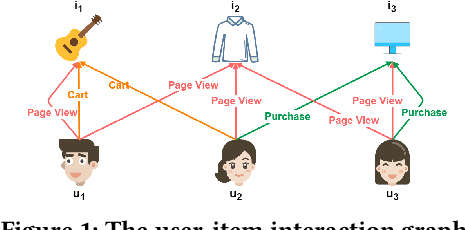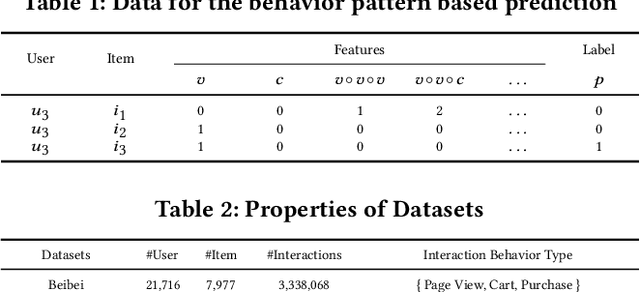Junwei Du
Behavior Pattern Mining-based Multi-Behavior Recommendation
Aug 22, 2024



Abstract:Multi-behavior recommendation systems enhance effectiveness by leveraging auxiliary behaviors (such as page views and favorites) to address the limitations of traditional models that depend solely on sparse target behaviors like purchases. Existing approaches to multi-behavior recommendations typically follow one of two strategies: some derive initial node representations from individual behavior subgraphs before integrating them for a comprehensive profile, while others interpret multi-behavior data as a heterogeneous graph, applying graph neural networks to achieve a unified node representation. However, these methods do not adequately explore the intricate patterns of behavior among users and items. To bridge this gap, we introduce a novel algorithm called Behavior Pattern mining-based Multi-behavior Recommendation (BPMR). Our method extensively investigates the diverse interaction patterns between users and items, utilizing these patterns as features for making recommendations. We employ a Bayesian approach to streamline the recommendation process, effectively circumventing the challenges posed by graph neural network algorithms, such as the inability to accurately capture user preferences due to over-smoothing. Our experimental evaluation on three real-world datasets demonstrates that BPMR significantly outperforms existing state-of-the-art algorithms, showing an average improvement of 268.29% in Recall@10 and 248.02% in NDCG@10 metrics. The code of our BPMR is openly accessible for use and further research at https://github.com/rookitkitlee/BPMR.
Amplify Graph Learning for Recommendation via Sparsity Completion
Jun 27, 2024



Abstract:Graph learning models have been widely deployed in collaborative filtering (CF) based recommendation systems. Due to the issue of data sparsity, the graph structure of the original input lacks potential positive preference edges, which significantly reduces the performance of recommendations. In this paper, we study how to enhance the graph structure for CF more effectively, thereby optimizing the representation of graph nodes. Previous works introduced matrix completion techniques into CF, proposing the use of either stochastic completion methods or superficial structure completion to address this issue. However, most of these approaches employ random numerical filling that lack control over noise perturbations and limit the in-depth exploration of higher-order interaction features of nodes, resulting in biased graph representations. In this paper, we propose an Amplify Graph Learning framework based on Sparsity Completion (called AGL-SC). First, we utilize graph neural network to mine direct interaction features between user and item nodes, which are used as the inputs of the encoder. Second, we design a factorization-based method to mine higher-order interaction features. These features serve as perturbation factors in the latent space of the hidden layer to facilitate generative enhancement. Finally, by employing the variational inference, the above multi-order features are integrated to implement the completion and enhancement of missing graph structures. We conducted benchmark and strategy experiments on four real-world datasets related to recommendation tasks. The experimental results demonstrate that AGL-SC significantly outperforms the state-of-the-art methods.
 Add to Chrome
Add to Chrome Add to Firefox
Add to Firefox Add to Edge
Add to Edge